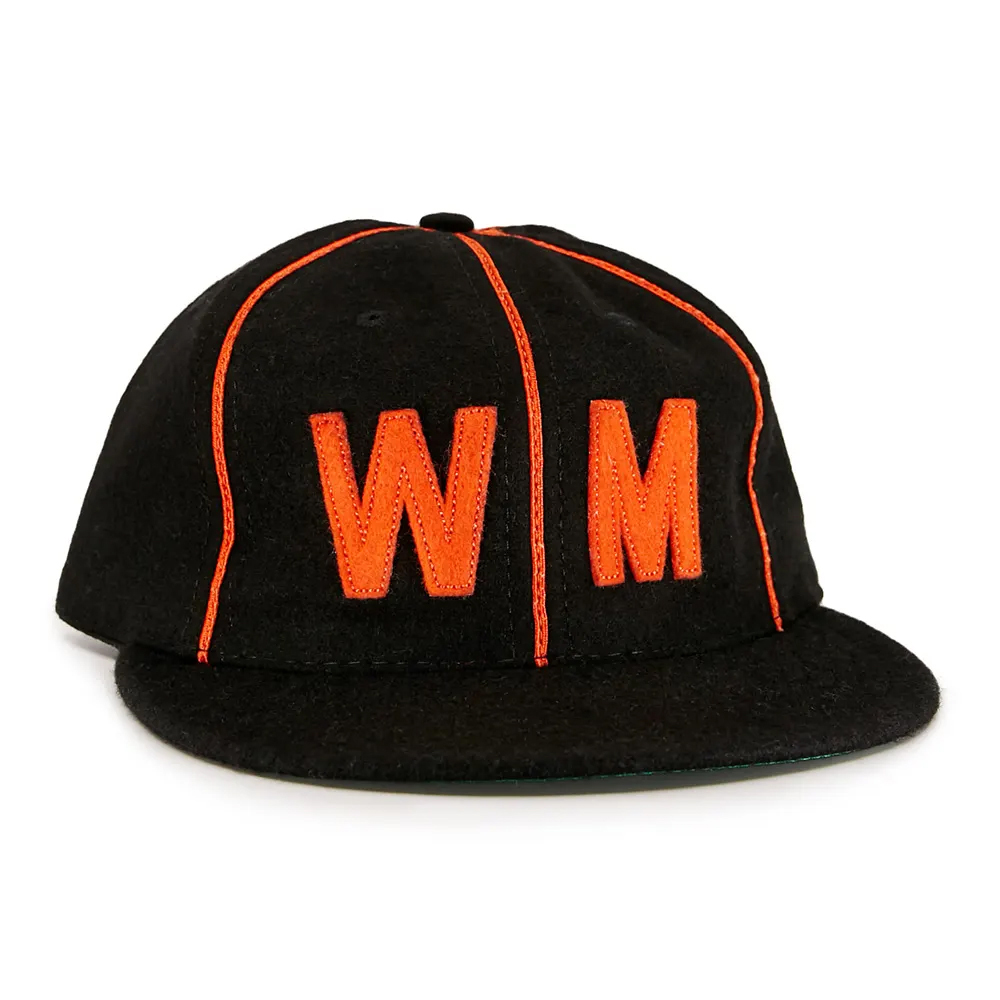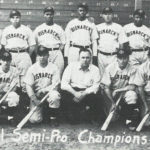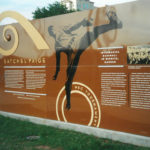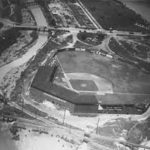One hundred years ago this summer, Wichita celebrated the opening of a baseball park unlike any seen here before or since.
Located at 12th and Mosley streets, Monrovian Park was built and named for Wichita’s entry in the Colored Western League. They were a black counterpart to Wichita’s Izzies, who played in the white class A Western League.
Opening day was a gala. Charles Prince Edward, described as a black attache of Wichita’s district court, spoke and then stuck around to umpire. S.W. Zickafoose, head of the city’s detective bureau, threw out the first pitch. A Wichita newspaper writer noted the crowd included “a large number of fans of both races.”
The Monrovians trounced Tulsa 8-1.
The game shows that appreciation for what was then unquestionably America’s favorite sport ran across color lines, despite whatever was taking place off the field. The Monrovians played in an all-black league, but outside the league, they were as likely to oppose a white team as one made up of black players. Teams and tournaments started integrating here in the early 1930s, more than a decade before Jackie Robinson became the first African American to play in the Major Leagues.
Sadly, no photographs or detailed descriptions of Monrovian Park seem to have survived. No photographs of the team’s players are to be found in collections of the Kansas Sports Hall of Fame, Wichita-Sedgwick County Historical Museum or The Kansas African American Museum.
But a little more is known about the Monrovians. The team’s president was J.B. Booker, described as a lawyer and political activist. The team’s name was a tribute to the capital of Liberia, an African nation founded by free black Americans in the 1800s. The Monrovians were one of the few black teams to own its own stadium. Ticket sales reportedly were used to support the Phyllis Wheatley Children’s Home and other social causes in the black community. Their catcher was named Thomas Jefferson Young.
The Monrovians had previously competed as the Black Wonders, then restyled themselves to join a new league featuring teams from Oklahoma City, Tulsa, Omaha, St. Joseph, Coffeyville, Independence and Kansas City. The Monrovians so dominated the league they may have destroyed it. They won 52 of their first 60 games, according to the Negro Star newspaper. By the end of the season, the league folded.
But the Monrovians did not. They continued to play anyone, anywhere, including a now legendary 1925 game against a Ku Klux Klan team at Wichita’s Island Park, located on Ackerman Island in the Arkansas River. The Wichita Beacon advised readers that “strangle holds, razors, horsewhips, and other violent implements of argument” would be barred at the gate. But there was no trouble, and the Monrovians defeated the KKK team 10-8.
The Monrovians were exceptional but not unique. In the early years of Wichita baseball, teams were strictly segregated. The Cudahy Packing Company, a major employer in the 1920s, sponsored two teams. One, called the Rex and made up of black players, would succeed the Monrovians as the city’s best black team. The Puritans were white. They sometimes played each other. But coverage of black baseball in the city’s two daily papers, The Eagle and Beacon, gave few accounts of wins and losses.
The Beacon did note that the all-white Campbell Merit Bread Company team faced the Monrovians in a doubleheader at Monrovian Park in August 1922. The game attracted “one of the largest crowds ever to attend a game at Monrovian Park and the crowd included both black and white fans.” But the winner is a mystery today.
While other white teams like the Wichita Advertisers, hailed as the best team in the city’s industrial league, also played black clubs, only white teams were allowed in the city’s amateur and semi-pro leagues. In 1924, there were five leagues in Wichita made up of 38 teams, all white. Black teams like the ABCs and Gray Sox played each other.
In 1932, a Mexican American team called the Aztecs was allowed to enter a city league. At the same time, a younger group known as the Mexican Midgets started play in the city’s junior league.
The next year, T. J. Young, a former Monrovian who with teammate Newt Joseph had gone on to the famed Kansas City Monarchs, tried to enter an all-black team in a city league here. It didn’t happen. Instead, Young joined Mulvane’s team in the Oil Belt League, making it the first known integrated team in the Wichita area.
The aforementioned Monarchs were a pioneer in white-black baseball. The Kansas City club not only played in Negro League games but barnstormed much of the year, playing white teams in Wichita and elsewhere. In 1927, the Monarchs drew 6,000 fans to a two-game series against the Wichita Advertisers.
In 1929, the Monarchs issued a challenge to the white Henry’s Clothiers team. The Monarchs would play Henry’s but only if the Wichitans could first beat the all-girl Wallenstein-Raffmans. The boys won, 4-0, and the Monarchs kept their promise to play the winners.
The Monarchs’ most noteable game here, however, may have come in 1930, when the team played in the city’s first night game, held at Cudahy Park in the North End’s meatpacking district. The Monarchs had just that year become the nation’s first professional team to use a portable lighting system, five years before the Major Leagues added lights. The game drew 3,000 fans.
Integration took a big step in the 1930s at state and national semi-pro tournaments. There were four black teams in Kansas’ 1932 state tournament, the best being Wichita’s Colored Devils, who won the first game but lost the next two. One of the Devils’ outfielders was Hubert King, one of the first black football players at what now is Wichita State University. King was a star end for the Shockers.
A year later, two black teams — the 9th Cavalry from Fort Riley and the Arkansas City Beavers — made strong showings. The Beavers, bolstered by two former Kansas City Monarchs, finished fourth. The next year, the black Wichita Elks were third in the final standings.
After that tournament, an integrated all-star team featuring three black players was chosen. One was Army Cooper, who pitched for the all-stars in a charity game against the Arkansas City Beavers, the tournament winners.
By 1935, the first national championship tournament organized by Raymond “Hap” Dumont, took black-white baseball a step farther. The Bismarck, N.D., team won that tournament behind the pitching of Leroy “Satchel” Paige, considered one of the best pitchers of any race or era. Paige’s team had five black and six white players on the roster. The $10,000 the team won would equal almost a quarter million dollars today. Paige was paid $400 a month that summer in North Dakota and provided with a car. Yet he and his wife were forced to live in an abandoned railroad car.
The 1935 tournament also was the first to be broadcast, in a manner of speaking. A leased wire from the stadium to a nearby pool hall carried the play-by-play so that fans outside the park could keep up with Paige’s pitching.
Black vs. white baseball in the first quarter of the 20th century without reported incidents among fans or players may have been unusual. It was a time of racial unrest. In 1919, there were 25 race riots nationally. Omaha, Tulsa and Independence all had deadly outbreaks in the 1920s. Here, even such potentially charged events as the Monrovian-Klan game were peaceful.
Baseball may have played a role. Larry G. Bowman, then a boy in McPherson, came to Wichita with his dad to see tournament games featuring both races. “I never recalled hearing derogatory remarks about a black player and wondered why there was so much excitement about Jackie Robinson when he rose to the majors,” he was quoted as saying in a 1997 article in Kansas History.
But Robinson understood why. During World War II, Kansas’ Fort Riley had one of the dominant semipro teams in Kansas. Robinson, who’d already gained famed as an athlete at UCLA, was assigned to a segregated calvary unit there. Robinson reportedly asked to try out for the Fort Riley semi-pro team, but was told he could only be on the “colored team.”
Five years after arriving at Fort Riley, Robinson started his Hall of Fame career at first base for the Brooklyn Dodgers.
Contact Bob Rives at bprives@gmail.com.















